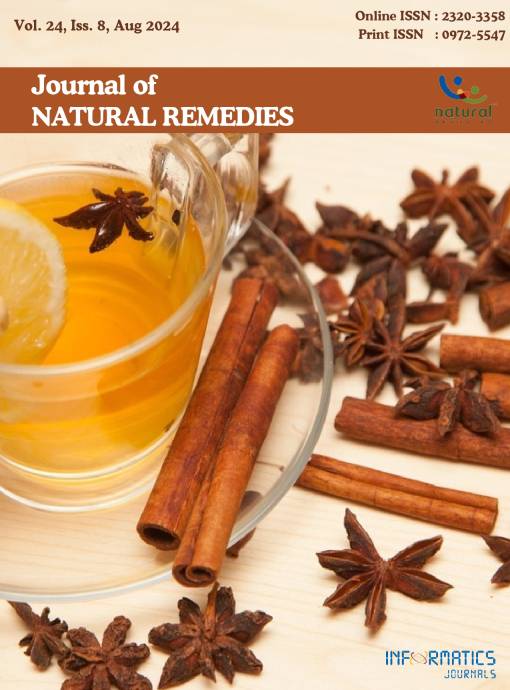Assessment of Effect of Patol-katurohinyadi Kwatha in Paracetamol Induced Hepato-toxicity in Albino Wistar Rats - An Experimental Study
DOI:
https://doi.org/10.18311/jnr/2024/34823Keywords:
Dushivisha, Hepatotoxicity, Hepato-protection, Histopathology, Patol-katurohinyadi Kwatha, ParacetamolAbstract
Background: The present study was planning to assess the hepato-protective and hepato-curative property of Patol-katurohinyadi (PK) kwath, in paracetamol induced hepatotoxicity in albino rats. Hepatotoxicity due to paracetamol and dushi visha concept can be correlated with each other and hepatoprotective formulations mentioned in Ayurveda samhita can play major role in this concept. A classical Ayurvedic formulation Patol-katurohinyadi of Ashtanga hridayam, has been reported to be effective in management of liver related diseases. Objective: To study the hepato-protective and hepato-curative properties of PK Kwatha in paracetamol induced hepatotoxicity in albino rats. Materials and Methods: The experimental study was carried out in albino rats as per CPCSEA guidelines after getting approval from the Institutional Animal Ethics Committee (IAEC). 30 Albino rats, each weighing about 150 gm to 200 gm, were procured from APT Testing and Research Pvt. Ltd. Pune. The rats were housed in the institutional animal house in standard conditions. 30 albino rats were equally divided into five groups having six animals in each group as normal control, disease control, test group, preventive group and curative group. To assess hepato-toxicity, the blood investigations such as RBC, WBC etc. Haematological parameters, biochemical parameters, and histopathological findings were carried out by monitoring rats on 0, 7 and 14 days of study. The results were derived by applying appropriate test to the data. Result: The animals administered with PCM only shows increase in values of SGPT, SPOT, ALP, Albumin, total protein compared to animals of control group. Whereas animals administered with PK Kwatha prevented PCM-induced changes in biochemical parameters and histopathological features. Conclusion: The histopathological results of liver show the potent efficacy of Patol-katurohinyadi kwatha on paracetamol induced hepatotoxicity. Also, we found that Patol-katurohinyadi kwatha as a good hepatoprotective and hepato-curative drug.
Downloads
Metrics
Published
How to Cite
Issue
Section
License
Copyright (c) 2024 Meera Shankarrao Kadam, Arvind Tumram (Author)

This work is licensed under a Creative Commons Attribution 4.0 International License.
Accepted 2024-07-01
Published 2024-08-31
References
Pandit A, Sachdeva T, Bafna P. Drug-induced hepatotoxicity: A review. J Appl Pharm Sci. 2012. p. 233-43. https://scholar.google.co.inhttps://doi.org/10.7324/JAPS.2012.2541.
Whelton A, De Bore ME, Porter GA, et al. Nonsteroidal anti-inflammatory drugs. In clinical nephrotoxins, 2nd ed, London, Kluwer Academic Publishers. 2003. p. 279-306. https://doi.org/10.1007/1-4020-2586-614
Tittarelli R, Pellegrini M, et al. Hepatotoxicity of paracetamol and related fatalities. European Review for Medical and Pharmacological Sciences. 2017; 95(21). https://www.ncbi.nlm.nih.gov
Tittarelli R, Pellegrini M, et al. Hepatotoxicity of paracetamol and related fatalities. European Review for Medical and Pharmacological Sciences. 2017; 97(21). https://www.ncbi.nlm.nih.gov
Tittarelli R, Pellegrini M, et al. Hepatotoxicity of paracetamol and related fatalities. European Review for Medical and Pharmacological Sciences. 2017; 99(21). https://www.ncbi.nlm.nih.gov
Tripathi B, Sthana AS. Reprint Edition, Delhi, Chaukhamba Sanskrit Pratishthan. Chapter No.15, Shodhanadigansamhrah Adhyaya. 2015. p. 199.
Kaviraj SA, Sthana SSS. Vol. 1, Reprint Edition, Varanasi, Chaukhamba Sanskrit Sansthan, Chapter No. 38: Dravyasamgrahaniy Adhyaya. 2014. p. 185.
Kamat SD, Dhanvantari Nighantu. First Edition. Delhi, Chaukhamba Sanskrit Pratishthan, Chapter No.1: Guduchyadi varga. 2002. p. 1-2.
Mishra B., Bhavprakash by Bhavmishra Vidyotini Tika, Purvardh, 10th Edition, Varanasi, Chaukhamba Sanskrit Sansthan. 2000.
Mishra B, Bhavprakash by Bhavmishra Vidyotini Tika, Purvardh, 10th Edition, Varanasi: Chaukhamba Sanskrit Sansthan. 2000.
Kamat SD, Dhanvantari Nighantu, First Edition, Delhi, Chaukhamba Sanskrit Pratishthan, Chapter No.3: Chandanadi varga. 2002. p. 24-2.
Mudiganti RR, et al. Phytochemical and GC MS analysis of an Ayurvedic Formulation, Patolakaturohinyadi Kwatham. International Journal of Pharmaceutical Sciences Review and Research. 2015; 34(2):6-12. https://www.researchgate.net
Shah VN, et al. In vivo and in vitro antioxidant effects of classical Ayurvedic formulation Punarnavasthak kwatha against Ethanol induced Hepatotoxicity. Pharmacognosy Journal. 2010; 2(16):43-52. https://doi.org/10.1016/S09753575(10)80049-5
Mudiganti RR, et al. Phytochemical and GC MS analysis of an Ayurvedic Formulation, Patolakaturohinyadi Kwatham. International Journal of Pharmaceutical Sciences Review and Research. 2015; 34(2):6-12. https://www.researchgate.net
Tripathi B., Astanghrdayam Sutra Sthana, Reprint Edition, Delhi, Chaukhamba Sanskrit Pratishthan, Chapter No.15: Shodhanadigansamhrah adhyaya. 2015. p. 199.
Kaviraj SA., Sushrut Samhita Sutra Sthana Vol-1, Reprint Edition. Varanasi, Chaukhamba Sanskrit Sansthan, Chapter No. 38: Dravyasamgrahaniy adhyaya. 2014. p. 185.
Hemabarathy B, et al. Paracetamol hepatotoxicity in rats treated with crude extract of Alpinia galangal. J Biol Sci. 2009. p. 1-7. https://doi.org/10.3923/jbs.2009.57.62.
Shah VN, Doshi DB, Shah MB, Bhatt PA. Evaluation of Hepatoprotective and antioxidant activity of classical Ayurvedic formulation Punarnavashtak kwatha against paracetamol induced hepatotoxicity in rats. APMC College of Pharmaceutical Education and Research, Himatnagar-380001, Gujrat, India. Invent.in>impact>clinical-research

 Meera Shankarrao Kadam
Meera Shankarrao Kadam









 0.35
0.35 24
24 0.161
0.161